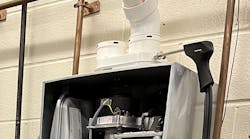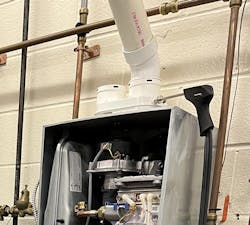Most people in our industry understand the value a combustion analyzer brings to combustion safety testing. However, it’s easy to forget that they are also exceptional diagnostic tools. But, if you don’t know how to interpret the analyzer’s readings, you can miss some common and frustrating problems.
One problem that drives technicians mad is a condensate drainage issue on 90% (condensing) furnaces. Sometimes, this problem is obvious because you hear the “washing machine” sound as you approach the furnace. But at other times, the problem is intermittent and difficult to find. This often occurs on the coldest night of the year, and without a combustion analyzer, you will probably miss it.
Let’s look at how an important combustion analyzer reading can help you discover an imminent condensate drainage problem, the common causes, and how to correct them.
A Frustrating Situation
It’s the coldest night of the year during a weeklong cold snap, and your phone rings. It’s an emergency no-heat call.
When you arrive at the customer’s home, you find a condensing furnace locked out on a pressure switch fault. You go through your diagnostic checks, and everything tests out fine – there’s no sign of an issue with the equipment. The pressure switch is good. It has plenty of vacuum to pull the switch down, all hoses are tight and in good shape, and the trap and drain are clean. Everything is mechanically sound.
You can measure CO in the flue gas and look for a pattern in the readings that reveals a drainage issue and if the pressure switch will trip.
You tell the customer to watch the furnace and explain it must have been a glitch. A few hours pass, and your phone rings again – the furnace is doing the same thing. You ask the customer to turn the power off to the furnace and back on to get their heat running. The issue continues until the cold snap passes, and then the intermittent lockout magically disappears. You’re stumped. Sound familiar?
Identify the Cause
One way to identify the cause of this situation is by using carbon monoxide (CO) measurements from a combustion analyzer. You can measure CO in the flue gas and look for a pattern in the readings that reveals a drainage issue and if tYhe pressure switch will trip.
To perform this test, you’ll need a combustion analyzer capable of measuring CO, a small drill/impact gun with a step-bit, and test port plugs.
Install a test port into the exhaust pipe, a minimum of 12 inches away from the inducer outlet. This is typically a 3/8-in. opening but can vary in size depending on your analyzer probe diameter and test plug size. If you live in an area where installing a test port in the exhaust is against code, you can measure at the exhaust penetration of a sidewall termination. For the rest of the article, we’ll assume you can test at the furnace.
Turn your combustion analyzer on outdoors and allow it to zero out, then come back inside and insert the analyzer probe into the exhaust pipe test port.
Set the thermostat to call for heat. After the furnace runs for a few minutes, start recording CO readings at one-minute intervals for up to 15 minutes of run time. Seal the test port once your testing is complete so it doesn’t leak.
Diagnose the Readings
You must be patient and watch the CO readings pattern to catch this problem. If you rush, you’ll miss the trend the analyzer reveals. A problem-free furnace should have CO readings under 100 ppm that are stable during the entire run cycle, as shown below.
|
Time |
6 min |
7 min |
8 min |
9 min |
10 min |
11 min |
12 min |
13 min |
14 min |
|
CO |
20 ppm |
20 ppm |
20 ppm |
20 ppm |
20 ppm |
20 ppm |
20 ppm |
20 ppm |
20 ppm |
Notice the CO readings above are constant and never climb above 20 ppm. This is a sign the furnace is safe and that the pressure switch won’t trip because of a hidden issue. Now, consider the readings below. They show an unsafe furnace that will likely have random pressure switch trips.
|
Time |
6 min |
7 min |
8 min |
9 min |
10 min |
11 min |
12 min |
13 min |
14 min |
|
CO |
20 ppm |
20 ppm |
21 ppm |
21 ppm |
22 ppm |
22 ppm |
23 ppm |
23 ppm |
24 ppm |
The CO readings above slowly rise from 20 to 24 ppm during furnace operation. These readings suggest the pressure switch will eventually trip and lock out the furnace. The furnace is also unsafe because CO readings should never rise during furnace operation!
What’s the Cause?
So, what could cause the CO readings to rise slowly? One potential suspect is condensate backing up in the venting system or trap assembly. Condensate slowly accumulates and restricts the venting system and drain, resulting in slowly rising CO readings.
If you’ve ever seen condensate rapidly pour out of the condensate drain after the inducer shuts off, you’ve witnessed this problem in action. The inducer’s suction prevents condensate from draining until the motor shuts off and lets gravity take over. This is the same action on an air handler drain with no trap in the condensate line.
This issue commonly shows up during extended run times. The furnace often doesn’t run long enough during an average winter day for excessive condensate production. That’s why the problem seems to magically fix itself on moderate days but reappears on the coldest nights.
Common Issues and Repairs
Sometimes, you’ll find a condensate drainage problem is nothing more than a condensate pump terminated to the outdoors. It may have frozen and must be thawed.
Some issues are trickier to diagnose. They include exhaust pipes that are too short, too long or have back-to-back elbows acting as traps. These issues can trap condensate and prevent draining during extended furnace operation.
You can avoid many of these problems by following proper venting design and installation procedures. There are more advanced repairs, but they’re beyond the scope of this article and addressed in the NCI Combustion Performance and Carbon Monoxide Safety class.
Next Steps
You can use combustion analyzer measurements for more than safety testing if you know what to look for. While this article addresses condensing furnaces, the test works for any condensing equipment. Try it and see what you find.
It’s an excellent investment to equip yourself and your team with the test instruments and skills necessary to add this test to your service procedures. If you slow down and test, you might save yourself a callback on the coldest night of the year and maybe a customer’s life while you’re at it.
David Richardson serves the HVAC industry as Vice President of Training for the National Comfort Institute, Inc. (NCI). NCI specializes in training focusing on improving, measuring, and verifying HVAC and Building Performance.
If you’re an HVAC contractor or technician interested in learning more about testing and diagnosing with a combustion analyzer, contact David at ncilink.com/ContactMe. NCI’s website, www.nationalcomfortinstitute.com, is full of free information to help you improve your professionalism and strengthen your company.










